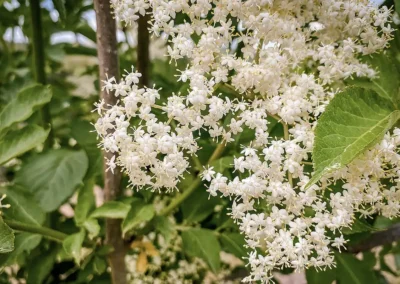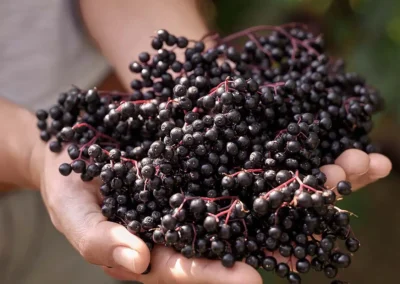
The black elderberry
(SAMBUCUS NIGRA L.)
Very early in human history, elderberry played a major role. Already Hippocrates reported in his famous writings about the positive effect of the black berries on humans. The use of the elderberry was so versatile over the last centuries that the respected physician, surgeon and botanist Michael Ettmüller in the 17th century called the black elderberry the “medicine chest of the rural population “*.
In the same period, the German physician Martin Blochwitz wrote a handbook entitled “The Anatomy of Elderberry”, which is still considered a standard work on elderberry and its uses. In it, he described the plant’s many positive effects. In the following centuries, his findings were expanded, refined and finally proven by scientific studies. Here it was confirmed once again that the elder is not without reason also called the “Lord God’s pharmacy” *.
Hardly any other plant is used as versatile as food to support a healthy lifestyle as the black elder. It therefore plays a crucial role in nature’s medicine cabinet.
* At this point it should be mentioned that the medicine cabinet of ancient times was synonymous with a healthy diet from nature, which served primarily to enhance the daily diet. In today’s parlance, one speaks of food supplements.
The hash mountain elder
also called elderberry
The coloration of the berries is one of the most important criteria in elderberry, and therefore the variety is also of particular importance. The well-known shrub and wild elderberry, which grows in large numbers on the edges of forests and in our gardens, is lighter and less intense. Much darker is the black elderberry, also called Sambucus nigra L.. However, the cultivated black elderberry of the Haschberg variety used for rubyni® from elderberry cannot be surpassed in quality and dark, strong coloration.
In the 1960s, a professor at the Higher Federal Office for Viticulture and Fruit Growing in Klosterneuburg on the Danube commissioned his students to collect wild elderberries of various origins in the surrounding flora of the Danube floodplains and to examine them with regard to their uniform ripeness within the umbel. Quickly one plant crystallized as something special, which exceeded all expectations with its deep dark berries. In 1965, this elderberry was named Haschberg elderberry in honor of the place where it was discovered. To this day, only this elderberry is the basis for rubyni® made from elderberries. Our elderberries are late ripening, which allows them to develop their deep red, almost black berries. We obtain our elderberries of the Haschberg variety only from selected farmers in the southeast of Austria. Thus, we can ensure that only the elderberries of particularly high quality are used in rubyni® from elderberry.


The cultivation areas
spoiled by the sun
We obtain our black elderberry of the Haschberg variety exclusively from Styria and Burgenland in Austria. These provinces now have the world’s largest cultivation area of the healthy berries. The climatic conditions of this region and the nutrient-rich soils that are thus excellent for these trees contribute significantly to the consistent quality of our elderberries. More than 250 contract farmers guarantee us and you that only the best black elderberries are harvested and passed on to our processing chain.
The history
Sambucus Nigra L. in human history
370-460 v. Chr
Hippocrates classifies elderberry as a valuable food source and medicinal plant.
40-90 v. Chr
Pedanius Dioscorides, a well-known botanist and physician of ancient Greece, describes the effect of black elder as cooling and dehydrating.
1644
The German physician Martin Blochwitz was the first to describe a syrup made from elderberry. This found its various uses in maintaining health, here especially for children.
1644-1683
The physician, surgeon and botanist Michael Ettmüller proclaims the black elder as the "medicine chest of the country folk".
1918 - 1919
During the Spanish flu of 1918 - 1919, black elderberry was a widely used household remedy.
1931
Elderberry extract is for the first time thoroughly examined for its positive effects within the framework of a scientifically designed study.



